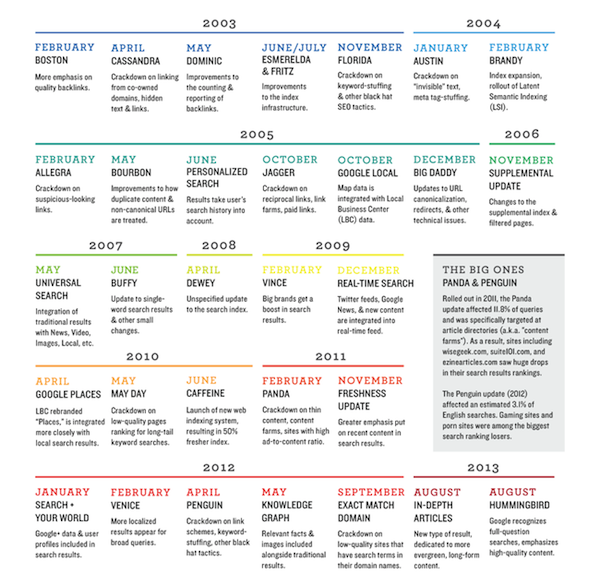
At its core, the job of the SEO entails bridging the gap between the technical needs of search engine bots and the human needs for information, products or services – all for the purpose of increasing an organization’s revenue. Whether that revenue is gained from products sold, leads captured, or page views earned, SEO professionals must justify the existence of their role through metrics while using these metrics to continually optimize the performance of keywords and landing pages against revenue.

Image Credit: HubSpot
Given the frequency of search engine algorithm updates, continual competitive activity, ever-shifting business priorities and the proliferation of content delivery and sharing mechanisms, the SEO’s job is constantly evolving. The task of staying up to date with industry trends, best practices, and algorithm updates is often explicitly mentioned on job descriptions for SEO analysts and managers and cannot be deemphasized.
For example, many standby SEO analytics best practices became obsolete in just the past year with Google’s switch to secure search and Microsoft and Yahoo’s recent moves to encrypt keyword data. In the world of secure search, measuring performance against keyword traffic is no longer possible.
Adjusting to page-centric SEO and more closely integrating with content marketing is currently the most pressing evolution in SEO best practices. What are the primary qualities needed to adapt and thrive in SEO in 2014 and beyond?

Image Credit: BrightEdge
SEO also must bridge many gaps within their organizations if they are to truly be effective.
Bridging the Knowledge Gap
A benefit of accurately assessing which content (pieces of content and content campaigns as a whole) were most successful in generating results is greater budget allocation toward content. More budget equals more revenue, increasing the importance of SEO within the marketing organization.
Knowledge of Content Performance
If connecting content to ROI is the goal, information is the primary the primary means to get there. SEOs must be relentless in their pursuit of knowledge about content performance and make the most out the tools they have to understand what improves its performance.
The most important content measurement factors in the page-based approach are:
- Understanding the business impact of pages or content in terms of actual conversions and revenue.
- Understanding content performance at the individual page level as well as the page group level.
- Understanding content performance across search engines, geographies, and devices.
- Assessing the impact of keywords by attributing revenue, conversions and traffic.
Knowledge of Rank
Knowledge about content performance and the impact of keywords is only one piece of the information puzzle, however. In a world of social media, multiple device types, Universal Search, and search result variations across geographies, identifying anomalies in keyword rank and explaining the root cause of these anomalies becomes a more complex task. Ranking factors to consider:
- Accuracy of rank data.
- Understanding the correlation between social sharing of pages and rank for those pages.
- Measuring actual rank across text, video, image site link, and Places results.
- Measuring rank across variables such as device types, local search markets, global search markets, and multiple search engines.
- Ranking in Google Carousel, if applicable.
But the quest for perfect knowledge of ranking factors and their contribution to content performance can lead to analysis paralysis that prevents this data from being put into action. Without cross-functional collaboration, the SEO is a lone ranger.
Bridging the Gap Between Teams
As champions of the search user, SEO professionals can interact with departments, such as engineering, development, marketing, product, and creative services. This cross-functional collaboration and evangelism is essential for a successful SEO program.
One question to ask is, “Are you satisfied with the search engine-friendliness of your content?” Then focus on what can be done to improve legacy content, and what can be done going forward to optimize content as it is created. Is the content being optimized before, during, or after its creation? Who needs to be involved in creating a streamlined process for your organization?
While most companies have a CMS, a large portion of content is still being created in basic programs like Microsoft Word that do not offer SEO capabilities for content creators. Content creators are often focused on thinking for the end user, and often need training on how to think for search engines. Evangelism across teams is just as important as the basic collaboration necessary to get the job done.
Bridging the Data Gap
There are many sources of data that contribute to the execution of a top-notch enterprise SEO program. All data is relevant and connected.
Analytics integration is a necessity in the page-based approach, and secure search has solidified the need for integration with Google Webmaster Tools.
Data to inform link building and keyword discovery is also important – and the more existing tools can integrated into one program, the easier it will be to find correlations and causations that contribute to SEO success.
Bridging the data gap is essential for bridging the knowledge gap.
Conclusion
There is no more exciting time to be in SEO. Unlike engineers, who mostly work with code, or content creators, who mostly work with words and images, SEO professionals have the benefit of sitting at the intersection of technology and human behavior. It is their ability to bridge these gaps in knowledge, between cross-functional teams, with data, and with technology providers that will ensure their success in 2014 and beyond.
![]()
Early Bird Rates Expire Soon!
ClickZ Live (Mar 31-Apr 3) is a brand new global conference series kicking off in New York City. Over 3 days of sessions, keynotes, training workshops and networking you’ll gain invaluable digital marketing and advertising take-aways.
Register now and save up to $400 ››
*Early Bird Rates expire Feb 21.
Article source: http://searchenginewatch.com/article/2329129/Bridging-the-Gap-A-Recipe-for-Enterprise-SEO-Success-in-2014
